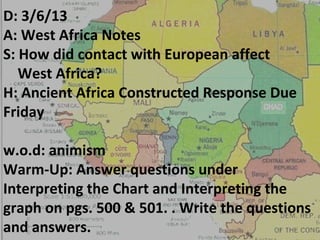
west africa
- 1. D: 3/6/13 A: West Africa Notes S: How did contact with European affect West Africa? H: Ancient Africa Constructed Response Due Friday w.o.d: animism Warm-Up: Answer questions under Interpreting the Chart and Interpreting the graph on pgs. 500 & 501. . Write the questions and answers.
- 2. Word of the Day Word Definition Sentence Picture A religious belief that In animism animism bodies of you also water, honor your tress, ancestors. animals and other natural object have spirits
- 3. West Africa
- 4. Nigeria A. Has both tropical savanna & steppe climate B. Rainforests found in Tropical regions with mangroves C. Harmattan or dusty winds blow in winter months D. Is a leader in world oil production. 90% of the country’s money comes from oil and is used to build roads, schools, and factories
- 5. Nigeria E. Most Nigeria’s are farmers and grow rubber, peanuts, palm oil and cacao F. Is the most diverse country in Africa. G. There are over 300 ethnic groups and most live in compounds H. Nigeria was settled by the Nok people. In the north they became Muslim When Europe colonized many became Christian. In 1960 they became independent and since civil war has tore the country apart
- 6. The Sahel Countries A. This area receives very little rainfall so has little vegetation B. Herders have allowed animals to overgraze C. Often the region suffers from drought and desertification D. There have been 3 major empires that ruled here. Ghana, Mail & Songhai. That controlled gold and salt trade. E. The French took control in 1800s until 1960
- 7. The Sahel Countries F. The People of the Sahel live in the South, farmers, practice Islam, speak Arabic and African languages and live in small towns or are nomads G. Mauritania is known for fishing & iron H. Mali & Burkina Faso are among the poorest in the world I. Niger has uranium used to make nuclear weapons J. Chad lacks the money to develop the resources they have.
- 8. Coastal Countries A. These countries have lots of rainfall and thus people farm yams, corn, rice, cassava, coffee, rubber, cacao& kola nuts. B. When European colonized this region they forced many Africans into slavery to the Americas. C. Today the people cherish their family ties, practice Islam or Christianity, speak African for everyday use and European languages for business D. Gambia, Senegal & Guinea are known for diamonds, bauxite and phosphate.
- 9. Coastal Countries E. Guinea-Bissau & Cape Verde were once Portuguese colonies. In Guinea-Bissau people farm rice and fish. They are also known for growing cashews F. Liberia & Sierra Leone were both founded by African who were freed from slavery. Civil War has destroyed these countries especially from the diamond mines G. Cote d’Ivoire used to be the center for the Ivory trade and was French. Today they are a top producer of cacao, coffee and palm oil H. Ghana is known for cacao, gold and timber.
- 10. Coastal Countries E. Guinea-Bissau & Cape Verde were once Portuguese colonies. In Guinea-Bissau people farm rice and fish. They are also known for growing cashews F. Liberia & Sierra Leone were both founded by African who were freed from slavery. Civil War has destroyed these countries especially from the diamond mines G. Cote d’Ivoire used to be the center for the Ivory trade and was French. Today they are a top producer of cacao, coffee and palm oil H. Ghana is known for cacao, gold and timber.